
A pancake is a flat cake, often thin and round, prepared from a starch-based batter that may contain eggs, milk and butter and cooked on a hot surface such as a griddle or frying pan, often frying with oil or butter. It is a type of batter bread. Archaeological evidence suggests that pancakes were probably eaten in prehistoric societies.

Pound cake is a type of cake traditionally made with a pound of each of four ingredients: flour, butter, eggs, and sugar. Pound cakes are generally baked in either a loaf pan or a Bundt mold. They are sometimes served either dusted with powdered sugar, lightly glazed, or with a coat of icing.
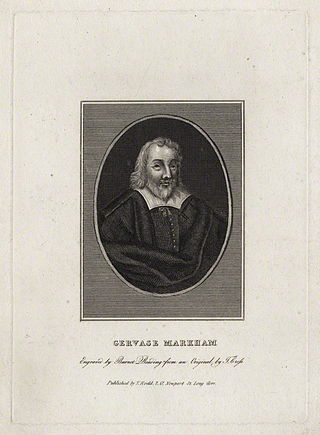
GervaseMarkham was an English poet and writer. He was best known for his work The English Huswife, Containing the Inward and Outward Virtues Which Ought to Be in a Complete Woman, first published in London in 1615.

Shortcake generally refers to a dessert with a crumbly scone-like texture. There are multiple variations of shortcake, most of which are served with fruit and cream. One of the most popular is strawberry shortcake, which is typically served with whipped cream. Other variations common in the UK are blackberry and clotted cream shortcake and lemon berry shortcake, which is served with lemon curd in place of cream.
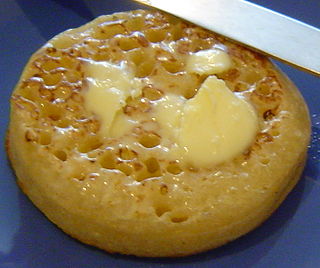
A crumpet is a small griddle bread made from an unsweetened batter of water or milk, flour, and yeast, popular in the United Kingdom, Canada, New Zealand, South Africa and Australia.
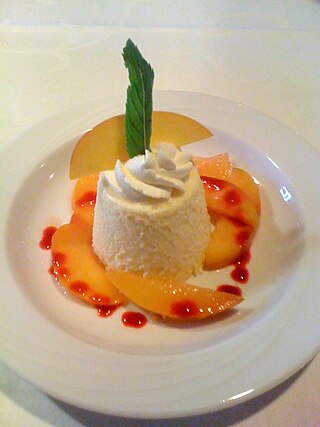
Flummery is a starch-based, sweet, soft dessert pudding known to have been popular in Britain and Ireland from the 17th to 19th centuries. The word has also been used for other semi-set desserts.

The Compleat Housewife; or, Accomplish'd Gentlewoman's Companion is a cookery book written by Eliza Smith and first published in London in 1727. It became extremely popular, running through 18 editions in fifty years.

A Banbury cake is a spiced, oval-shaped, currant-filled pastry. Since the mid-1800s Banbury cakes have grown more similar to Eccles cake but the earlier versions of Banbury cakes are quite different from the modern pastry. Besides currants, the filling typically includes mixed peel, brown sugar, rum, and nutmeg. Banbury cakes are traditionally enjoyed with afternoon tea.
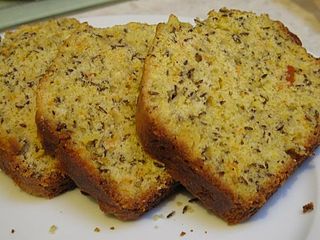
Seed cake is a traditional British cake flavoured with caraway or other flavoursome seeds. Caraway seeds have been long used in British cookery, and at one time caraway-seed biscuits were prepared to mark the end of the sowing of the spring wheat. These particular biscuits later evolved into this distinctively flavoured teacake.
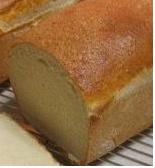
Manchet, manchette or michette, is a wheaten, yeast-leavened bread of very good quality, or a small flat circular loaf. It was a bread that was small enough to be held in the hand.
Hodge-podge or hotch potch is a soup or stew, usually based on diced mutton or other meat, with green and root vegetables. It is familiar in different versions in Britain and North America and is particularly associated with Scotland.

Nun's puffs are a dessert pastry originally from France, where they were known as pets de nonne. They are now also produced in French Canada, the United States, England, and Spain.

Sponge cake is a light cake made with egg whites, flour and sugar, sometimes leavened with baking powder. Some sponge cakes do not contain egg yolks, like angel food cake, but most of them do. Sponge cakes, leavened with beaten eggs, originated during the Renaissance, possibly in Spain. The sponge cake is thought to be one of the first non-yeasted cakes, and the earliest attested sponge cake recipe in English is found in a book by the English poet Gervase Markham, The English Huswife, Containing the Inward and Outward Virtues Which Ought to Be in a Complete Woman (1615). Still, the cake was much more like a cracker: thin and crispy. Sponge cakes became the cake recognised today when bakers started using beaten eggs as a rising agent in the mid-18th century. The Victorian creation of baking powder by English food manufacturer Alfred Bird in 1843 allowed the addition of butter to the traditional sponge recipe, resulting in the creation of the Victoria sponge. Cakes are available in many flavours and have many recipes as well. Sponge cakes have become snack cakes via the Twinkie.

The Housekeeper's Instructor was a bestselling English cookery book written by William Augustus Henderson, 1791. It ran through seventeen editions by 1823. Later editions were revised by Jacob Christopher Schnebbelie.

Elinor Fettiplace's Receipt Book is a 1986 book by Hilary Spurling containing and describing the recipes in a book inscribed by Elinor Fettiplace with the date 1604 and compiled in her lifetime: the manuscript contains additions and marginal notes in several hands. Spurling is the wife of a descendant of Fettiplace who had inherited the manuscript. The book provides a direct view of Elizabethan era cookery in an aristocratic country house, with Fettiplace's notes on household management.
Battalia pie is an English large game pie, or occasionally a fish pie, filled with many small "blessed" pieces, beatilles, of offal, in a gravy made from meat stock flavoured with spices and lemon. The dish was described in cookery books of the 17th and 18th centuries.

The Good Huswifes Jewell is an English cookery book by the cookery and housekeeping writer Thomas Dawson, first published in 1585. It includes recipes for medicines as well as food. To the spices found in Medieval English cooking, the book adds herbs, especially parsley and thyme. Sugar is used in many of the dishes, along with ingredients that are uncommon in modern cooking like violets and rosewater.

The English Art of Cookery is a cookery book of English cuisine by the tavern cook Richard Briggs, first published in 1788.

English Bread and Yeast Cookery is an English cookery book by Elizabeth David, first published in 1977. The work consists of a history of bread-making in England, improvements to the process developed in Europe, an examination of the ingredients used and recipes of different types of bread.

Tansy was a traditional Easter food in medieval English cuisine. Its name came from the Tanacetum vulgare plant. The simplest version of the recipe was made by baking a batter flavored with green tansy juice. Later recipes, like the one from the 16th-century Good Housewife's Handbook added more ingredients like parsley, feverfew and violets to an egg batter that was fried like pancakes, though with a slightly green coloring from the addition of tansy and other herbs. Baked tansy could also be given a green color by adding spinach juice. An 18th-century recipe from The Compleat Housewife added sack to the batter and sweetened the fried tansies with gooseberries and a topping of crushed sugar.




















